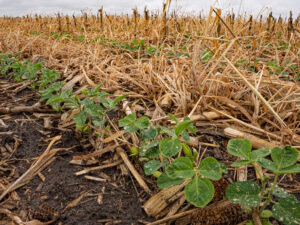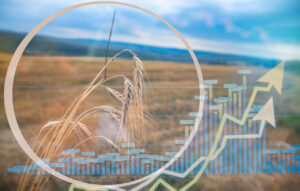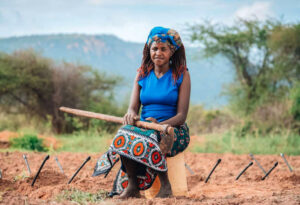A pioneering project exploring ancient environmental DNA (eDNA)—genetic material left by plants, animals and microbes in soil sediment, ice, and other sources up to two million years old—could help scientists develop more climate resilient crops by understanding how ecosystems have adapted to environmental change in the past.
The Ancient Environmental Genomics Initiative for Sustainability (AEGIS) project has been awarded DKK585 million ($85 million) over seven years, with the lion’s share ($72 million) coming from Danish nonprofit Novo Nordisk Foundation and the remainder from UK charity the Wellcome Trust.
By sequencing DNA fragments from samples all over the world and comparing them to the DNA in modern reference genomes, researchers can better understand past genetic diversity and learn how ancient species adapted to their environments, claims research leader, evolutionary geneticist Professor Eske Willerslev from the University of Copenhagen and University of Cambridge.
While modern food crops are typically bred for traits such as higher yield or disease resistance, their wild-type ancestors had far great genetic diversity, developing a wide range of genetic variations that helped them survive in diverse and changing conditions, he said.
“By employing ecosystem modelling, we can pinpoint which combinations of species led to the most durable ecosystems in the past. This knowledge could serve as a blueprint for creating climate resilient food systems, enhancing both the crops we grow and the sustainability of the environments they grow in.”

‘We had the human genome project… this is the planetary genome project’
The expectation is that AEGIS will demonstrate proof-of-concept in key crops such as barley, wheat, and rice, say the researchers, who span disciplines including bioinformatics, AI/ML, microbial ecology, plant breeding, and environmental genomics.
They will also create a public data portal featuring climate data, time points, sample types, genomic data, and reference genomes collected during the project, Novo Nordisk Foundation SVP Dr. Claus Felby told AgFunderNews.
“There’s DNA everywhere. In a teaspoon of soil, you can see DNA fragments from everything from bacteria and fungi up to the biggest mammal. So we had the human genome project… this is the planetary genome project; you can map everything in a given ecosystem. Every plant, tree, microorganism, every mammal that was there at a given point in time and then over time, so you can see how that ecosystem evolved and adapted over time.”
‘I can say the initial results so far are breathtaking’
So how far back are researchers looking?
“Anything between 10-50,000 years, that’s highly feasible,” said Felby. “And if you’re lucky, you can go back much further, I think the record [for collecting usable DNA] is about 2.5 million years.”
He added: “I can say the initial results so far are breathtaking. For instance, we have found how rice adapted to a much wetter climate [in a part of China] about 8,000 years ago. And you can see down to the single gene how the whole ecosystem adapted. You can also see how the microbiology of the soil has changed.”
According to Felby: “You can read the climate at the same time [as analyzing DNA fragments from a given period] by looking at things like oxygen isotopes because they change according to precipitation, temperature and so on. So then you can start to map the two things.
“But we’re not just looking at rice, or any given plant. We’re looking at the entire ecosystem. And if you see changes in all the plants, there’s a pattern.”
‘Bioinformatics big time’
Stepping back, he said, “We often speculate about what’s going to happen [to our ecosystems] with climate change. But all these experiments have been done before [if you look back far enough], and now we can read the results, and that’s fascinating.
“But it also allows for much more targeted and much faster [plant] breeding if you know where to look. It allows for polygenic traits, not just a single gene, but you see multiple genes changing at the same time. It’s like if you suddenly got a spaceship that would allow you to fly from one end of the solar system to the other in two hours.
“And now we have AI and machine learning and super-fast computers, we can handle these vast datasets. It’s bioinformatics big time. So as part of this project we are also building one of the world’s most powerful supercomputers here in Denmark with NVIDIA.”
Metagenomics—the study of genetic material recovered directly from environmental samples—has been around for a while, he said, “but this is the first time we are doing it at full ecosystem scale. We can map not just the effect of climate and climate change but also what happens to an ecosystem when humans enter, what happens when we develop agriculture, what happens when we start to apply fertilizers and pesticides?”
According to the European Molecular Biology Laboratory’s European Bioinformatics Institute, based at the Wellcome Genome Campus near Cambridge, UK:
- Through human cultivation, crop plants have lost the genetic diversity that was present in their wild-type ancestors
- Ancient environmental DNA found in the soil can help researchers understand how the ancestors of crop plants adapted to historical climate change
- These insights can be used to develop new strategies to make modern crops more resilient and provide novel solutions as climate change continues to threaten global food security
















Sponsored
Sponsored post: The case for or against ultra-processed foods is ‘tricky.’ Novel foodtech adds further nuance